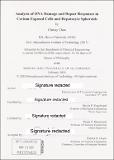| dc.contributor.author | Chao, Christy. | en_US |
| dc.contributor.other | Massachusetts Institute of Technology. Department of Chemical Engineering. | en_US |
| dc.date.accessioned | 2022-01-25T16:14:28Z | |
| dc.date.available | 2022-01-25T16:14:28Z | |
| dc.date.copyright | 2020 | en_US |
| dc.date.issued | 2020 | en_US |
| dc.identifier.uri | https://hdl.handle.net/1721.1/139716 | |
| dc.description | Thesis: Ph. D., Massachusetts Institute of Technology, Department of Chemical Engineering, February, 2020 | en_US |
| dc.description | Cataloged from the official PDF of thesis. | en_US |
| dc.description | Includes bibliographical references. | en_US |
| dc.description.abstract | Many environmental exposures, including airborne particulates and industrial chemicals, have long been known to impact public health and safety by contributing to the risk of developing cancer. One key concern is a chemical's potential to induce DNA damage, as damage can lead to the formation of mutations that drive cancer. While cancer can take years to develop following exposures, carcinogenicity can be predicted much earlier by studying a chemical's ability to damage DNA. These experiments are generally performed in vitro using cultured cells to predict responses in vivo. Due to limitations of cell culture systems, there is a growing interest in utilizing 3D cell culture models to better mimic conditions found in tissues. This thesis investigates the DNA damaging potential of cerium oxide (CeO₂) nanoparticles, and describes the development of an integrated platform for high-throughput spheroid culture and DNA damage analysis. CeO₂ nanoparticles are industrially valuable diesel fuel additives. While these additives improve fuel efficiency, studies have shown that exhaust contains CeO₂ nanoparticles. Gaining a better understanding of the biological effects of these nanoparticles is necessary for making informed decisions on public health policies, and a major focus of this thesis is on the DNA damage and repair responses induced by CeO₂ exposure in mammalian cells. CeO₂ treated cells were studied using the CometChip, a cell-based assay that measures DNA damage. While double strand breaks and oxidative base lesions were not detected, single strand breaks were observed following CeO₂ exposure, raising the possibility of downstream health effects. DNA damage and repair were also analyzed in fibroblasts from apparently healthy and ethnically diverse people to learn about interindividual variation. Subtle differences in repair kinetics were observed among the samples tested, but in all cases, cells fully repaired CeO₂ induced DNA damage within a few hours. Although DNA repair was possible, I also observed that CeO₂ may induce cell stress, as evidenced by an increase in cytokine and interferon signaling pathways. Together, changes to DNA structure and the potential for CeO₂-induced stress responses highlight the potential health impact CeO₂ nanoparticles. It is now broadly appreciated that 3D cell culture models often mimic characteristics of tissues better than traditional 2D cell culture. These more biologically relevant systems are currently being developed as alternatives to animal testing. One area where predictive 3D models would be beneficial is liver toxicity studies, since hepatocytes have been shown to have improved levels of liver specific metabolic activity in 3D culture. While many complex platforms have been developed for this purpose, a very simple and effective approach is to create liver spheroids. Spheroids are cell aggregates that spontaneously form when cells are placed in low attachment environments. In this thesis, I describe the creation of a patterned agarose array for high-throughput spheroid formation and test its efficiency for DNA damage analysis. Specifically, the agarose chip contains a grid of ~100 microwells condensed into the area of a single well of a standard 96-well plate. HepG2 spheroids formed in these microwells through agarose assisted aggregation, and cell viability was maintained over time. To test efficacy for genotoxicity studies in intact spheroids, DNA damage and repair was directly measured in HepG2 spheroids cultured on this platform, following exposure to inflammatory chemicals (H₂O₂, SIN-1). The agarose array made it possible to assess DNA damage and repair in intact spheroids, enabling more physiologically relevant studies of DNA damage, compared to 2D cell culture. It is anticipated that this platform will have broad applications for studies of DNA damage and repair in hepatocytes. Taken together, this thesis provides new understanding of the biological impacts of CeO₂ nanoparticles, and introduces a new method for studies of DNA damage and repair under conditions that better represent tissues. | en_US |
| dc.description.statementofresponsibility | by Christy Chao. | en_US |
| dc.format.extent | 193 pages | en_US |
| dc.language.iso | eng | en_US |
| dc.publisher | Massachusetts Institute of Technology | en_US |
| dc.rights | MIT theses may be protected by copyright. Please reuse MIT thesis content according to the MIT Libraries Permissions Policy, which is available through the URL provided. | en_US |
| dc.rights.uri | http://dspace.mit.edu/handle/1721.1/7582 | en_US |
| dc.subject | Chemical Engineering. | en_US |
| dc.title | Analysis of DNA damage and repair responses in cerium exposed cells and hepatocyte spheroids | en_US |
| dc.type | Thesis | en_US |
| dc.description.degree | Ph. D. | en_US |
| dc.contributor.department | Massachusetts Institute of Technology. Department of Chemical Engineering | en_US |
| dc.identifier.oclc | 1292981527 | en_US |
| dc.description.collection | Ph. D. Massachusetts Institute of Technology, Department of Chemical Engineering | en_US |
| dspace.imported | 2022-01-25T16:14:28Z | en_US |
| mit.thesis.degree | Doctoral | en_US |
| mit.thesis.department | ChemEng | en_US |
